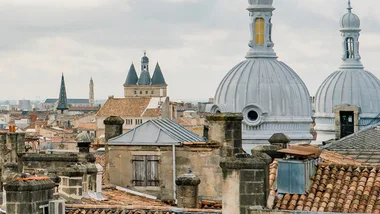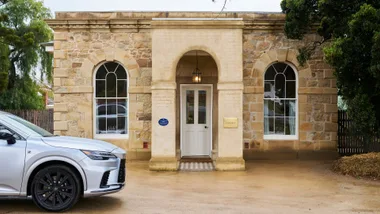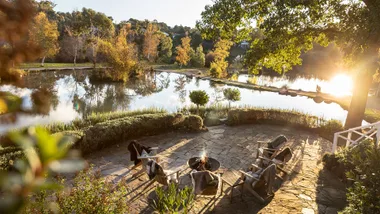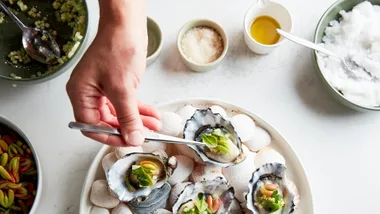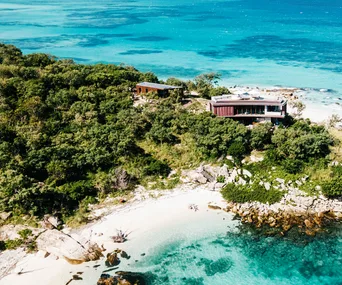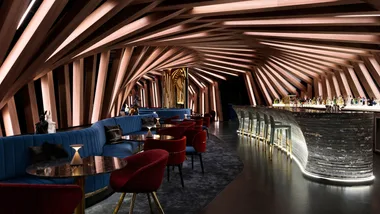THE FINE PRINT
GETTING THERE
Etihad flies to Paris from Australia via Abu Dhabi 16 times a week. Connecting flights depart from Sydney daily, from Melbourne on Tuesday, Saturday and Sunday, and from Brisbane on Monday, Thursday and Saturday. 1800 998 995.
**STAY
A magnificent, fully restored abbey with enormous, lavish interiors. The innovative restaurant is outstanding. Rooms $430-$800. La Bussière-sur-Ouche, +33 3 80 49 02 29.
Owned by a Japanese entrepreneur with a passion for Burgundy wines and golf, this château was once a fortress. The suites in the towers flanking the castle boast spiral staircases leading to a mezzanine level. Rooms $470-$1070 a night. Pouilly-en-Auxois, +33 3 80 90 30 30.
Domaine Comtesse Michel de Loisy
The family home of the Comtesse De Loisy, with winter garden, period furniture and open fires. Rooms $160-$233 a night. 28 rue Général de Gaulle, Route de Beaune, Nuits-St-Georges, +33 3 80 61 02 72.
Château de Chassagne-Montrachet
This famous winery offers accommodation with limited service but very well provisioned rooms. $440 a night. 5 rue du Château, Chassagne-Montrachet, +33 3 80 21 98 57
**EAT
Frédéric and Eva Ménager’s farmhouse serves unbelievable organic produce – absurdly cheap. From around $60 for three courses (wine not included). Bligny sur Ouche, +33 3 80 20 04 79.
After three generations of setting the standard for Burgundy cuisine with three Michelin stars, the Lameloise family has handed over the reins to the Eric Pras, who continues the tradition with classics such as snails. Mains $90-$135. 36 place d’Armes, Chagny-en-Bourgogne, +33 3 85 87 65 65.
The late Bernard Loiseau made this one of the best restaurants in France, with three Michelin stars. Chef Patrick Bertron has managed to maintain his legacy, both at the flagship in Saulieu and at Loiseau des Vignes, a smaller bistro in Beaune (below). Three courses around $135. Rue d’Argentine, Saulieu, +33 3 80 90 53 53.
Lunch from around $55. 31 rue Maufoux, Beaune, +33 3 80 24 12 06.
Classic, rustic Burgundy cuisine with staples such as snails, poached eggs and beef. Three courses around $46. 10 rue de la Chouette, Dijon,+33 3 80 30 99 99.
North African and French fusion cuisine, and some very successful twists on French classics. Mains around $35. 12 rue Odebert, Dijon, +33 3 80 50 09 26.
TOURS & GUIDES
Burgundy is still a secretive, reserved place in many ways, but with the help of a local guide to open doors it’s a much more rewarding experience. Marie Tesson-Naigeon’s Tours & Détours provides tailor-made experiences. Tesson-Naigeon spent many years in Australia and has a special enthusiasm for introducing Australians to the hidden treasures of Burgundy. 4 rue du Chambertin, Gevrey-Chambertin, +33 3 80 34 16 65.
TASTINGS
The concept of an open cellar door is quite new in Burgundy, but Maison Champy has been trading since 1720, and owner Pierre Meurgey is hospitable and fond of Australians. Charm him and you might get something exceptional. 5 rue du Grenier à Sel, Beaune, +33 3 80 25 09 99.
**SEE & DO
A World Heritage site. Montbard, +33 3 80 92 15 00.
La Ferme du Poiset
Détain-et-Bruant, +33 3 80 61 40 11.
GETTING AROUND
For train information, visit Rail Europe.
For further information, contact Maison de la France.
[Want to see more of Burgundy’s medieval abbeys, cobblestoned streetscapes, world-famous wineries and food? Then check out our slideshow.
](/burgundy-france-top-soil.htm)
Henry Miller got stuck in Dijon, Burgundy’s capital, for a few months in the 1930s, trying not very hard to be a teacher, and the experience calcified into a whole chapter of Tropic of Cancer. “Stepping off the train I knew immediately that I had made a fatal mistake”, it begins, and slumps from there into a caustic, sweary blast against “a hopeless, jerk-water town where mustard is turned out in carload lots, in vats and tuns and barrels and pots and cute-looking little jars”.
The cute-looking jars are still there, but what giveth the exasperation also taketh it away. The epic provincialism Miller railed against is defiantly still there, but now it looks more like a cultural resistance movement than the repressive force it once was. Give Burgundy time, and the place starts to seem like an oyster – prising open the recalcitrant dun shell isn’t just rewarded by sensation, it’s also part of the sensation, and for the persistent, it yields pearls.
The cool Burgundian pride that can prickle the visitor springs from a powerful compost of ancient tradition and mellowed power. “The thing you have to remember about the French,” an expat friend with a honed prejudice told me, “is where the attitude comes from. They’ve never got used to no longer being the centre of the world, so they just pretend.” You can still see Paris as a plausible centre of the West, but the idea that Dijon, a tiny city surrounded by flat fields and vineyards, was once the Washington of its day seems fantastic. But it’s true – not so long ago, power was as famous a Burgundian export as its wine, borne from a nobility that rivalled the King of France, and a cluster of monasteries that threatened the supremacy of the Pope.
The Abbaye de Fontenay was one of these monasteries, a mammoth stone complex sitting just outside the town of Montbard and founded by the Cistercian order almost a thousand years ago. Perfectly preserved through an unlikely combination of patronage, abandonment and good luck, its clipped gardens and cloisters milling with quiet tourists give the place a sense of tranquillity now. But at the height of its power a millennium ago, it was more like a devout factory, controlling dozens of farms, forests and trout pounds, making tiles and mining the rough hills nearby for iron. Perhaps the earliest proper metal-working factory in Europe is in the abbey, and astonishingly, the hydraulic hammer was invented in a stone room next to the river (a replica still clacks away, driven by a water wheel). The Cistercians weren’t just dedicating themselves to piety through manual labour, they were also making themselves rich and powerful, doing the slow work of dragging Europe out of the Dark Ages.
It was lonely, miserable work too: rising at 2.30 in the morning, dividing time between prayer and manual labour on one meatless meal a day. You get a sense of just how numbing it must have been walking into Fontenay’s dormitory, an awesome, cavernous stone hall, which on a brisk spring day is still cool enough to sting your nostrils. The sorry inhabitants once lumped here together on the floor with only thin mats to fend off a winter so bitter it could crack rock. There were just eight monks left in 1790, so poor they’d smashed up their own privies for the stone – the Revolution must have come as a relief. But until that reprieve, Cistercians spent hundreds of years with a daily measure of wine as their only pleasure, and they dedicated themselves to it with the ardour of the desperate.
“Does Burgundy have a local sport?” I ask Françoise Bidot, one of our guides, and she makes a motion with her hand, throwing back an invisible wine glass. “That is our local sport,” she says. “We are champions.” Wine is not just the sport but the art, geography, philosophy, religion, politics and love life of Burgundy. Churches, hotels, hospitals and of course monasteries all have wineries. People cram tiny vineyards into their backyards instead of tennis courts. Every homely bar has the same decoration, a map of Burgundy wineries which fills the same wall space that a print of dogs playing poker or a fox hunting scene might occupy in another country. It’s also a kind of league table, not just showing the hundreds of wineries Balkanised by centuries of donations, confiscations, sales, sub-letting, and inheritances, but also colour-coding them by quality.
It was the monks who came up with the grading system, refining knowledge that had existed since Roman times. The most modest wines take the name of the region, the next best a village, then there are the premiers crus, literally “first growths”. Those tiny scraps of red on the map, the grands crus that attract rhapsody and visitors from all over the world, owe nothing to their owners or their grapes (almost all pinot noir and chardonnay, words which never appear on Burgundian labels); the terroir is everything.
There’s no exact translation for what it means, but it’s somewhere between “dirt” and “sense of place”. You do get a sense of it by seeing it. We travel through the vineyards on bikes, snaking through gently hilly narrow roads and tiny villages with famous names like Pommard, past gnarled, stumpy bush vines still denuded, but only weeks from the appearance of the first flowers. There are cheery Gallic men at work in overalls and leaning against vans, burning scrap in drums; much of the work here is still done by hand, as it was hundreds of years ago. The coppery earth is furrowed and strung with wires, making the vineyards look strangely like the World War I battlefields that scarred this same landscape generations ago (conversation with some older residents here can still yield a speech on the bravery of Australians, which generally ends in handshakes and references to kangaroos).
“Here the vines must fight for survival,” says Bidot, over dinner. “What makes Burgundy wines special is great complexity, and that comes from the terroir: the minerals and elements, the air, the climate. A truly great wine is almost a transcendental experience. It should be like Merlin.” We are dining in Lameloise, a three-Michelin-starred, third-generation institution serving local cuisine since the 1920s. Bidot expands on her rhapsodic theme, going on to compare each of the premier cru wines we’re drinking to various authors. At a nearby table, a cluster of very young Japanese men are making their way through a cheese plate featuring local specialties such as the golden, seeping Epoisses (also a Cistercian invention). They turn out to be culinary students, and their faces alternate between industrious interest and rank disgust, willing their palates to acquire the unfamiliar taste, and not quite getting there. We meet Eric Pras, the humble new chef, and the first in a century not to bear the same name as the restaurant, and he explains some of the delicacies of changing the menu in a three-star restaurant. Jacques Lameloise himself is not here, but it turns out we will run into him later – by chance as it turns out – in the most unlikely place.
We meet him in a farmhouse, down the end of a long, remote road, its grading peeling off into dust in a way that looks peculiarly Australian. La Ferm de la Ruchotte at the end of this track is about what we expect: rough stones in the walls, a happy black pig snuffling about and a slim, mean dog on a chain. Less routine is the selection of vintage cars parked out the front – an ancient Lancia, two Porsches (a 1600 Super and a Speedster), and an Aston Martin Roadster, its engine still ticking itself cool. But even the cars are less surprising than their cargo. Inside this rustic building are at least four Michelin three-star chefs, among them Michel Rostang, Michel Troisgros, Jean-Paul Lacombe, and Jacques Lameloise himself, all here to enjoy the cooking of a man most people have never heard of.
Frédéric Ménager used to work in three-star restaurants as well, but he left because he didn’t like the food. “The meat was never good enough,” he says, his children scurrying under foot as he cooks. “We were using the best suppliers, but they were too expensive, and it still wasn’t right.” So he decided to do something that made him happy – packing up, heading to the middle of nowhere and perfecting his ingredients in a way that made him, as he puts it, “a pioneer”. Everything is biodynamic: his chickens, from breeds almost extinct elsewhere, make an eight-hour round trip just to be slaughtered to his satisfaction. The vegetables are picked from his own gardens the night before. The rabbit we’re having today, with all of its offal, is good enough to attract a Michelin constellation to his farmhouse table.
A kind-looking man on the other side of the room, seemingly there by chance, stands and offers his greetings to these famous cuisiniers. He turns out to be Henry Roch, one of the owners of Domaine de la Romanée-Conti, perhaps the best winery in the world, and he offers a couple of bottles of his personal label with his compliments. Jacques Lameloise leans from the Mount Olympus at the other end of the table, and pours us a glass. “Wine,” says Ménager simply, “is the soul of Burgundy cooking.”
“French people don’t realise how lucky they are,” he says later, as he carefully cuts some Comté cheese in the kitchen. “They can’t see how beautiful France is, how good the food is in Burgundy. I don’t want to just try and do this on my own. I want there to be more people living like this, to try to educate them.” Just then the table breaks into a clutter of conversation, and I ask what these culinary demigods are talking about. “Food,” apparently.
The next farmhouse we end up in is unusual for a different set of reasons. La Ferme du Poiset has a huge wooden table, but the walls are littered with ancient military paraphernalia, crossbows, pikes, cavalry sabres, even a busted kettle drum. “That belonged to Louis XVI’s bodyguard,” says our host Pierre Moine, pointing to a dusty red and gold tunic. He seems unimpressed when I point out that the man didn’t do a very good job. Like Ménager, Moine runs a farm that preserves the best traditions of pure Burgundy food – he makes artisanal goat’s cheese using the same techniques as “the grandmas” used to, as he puts it. His produce comes with a side dish of crazy paysan folklore as well. “A goat is like a woman,” Moine explains to me as we watch kids. I’m still digesting this maxim when he tries to convince me that water is unhealthy. “Water, when it is cold, makes fog, which gives you the flu. It can rust iron. Imagine what it does to your insides.” It’s better to drink wine, he says, just not too much, in case you get the something called “the winemaker’s disease”, where “your liver goes over your heart”.
“Be careful now,” he says once we’re indoors, handing me a glass of wine to accompany his subtle product. At first I fear “the winemaker’s disease”, but instead he tells a cautionary story about the last journalist who came here. The man wound up so shattered he had to be carried out into a car. His secretary called after a few days, asked if Moine would kindly answer just a few more questions, then reconstructed the whole forgotten interview. Before we drink, Moine also teaches us an old Royalist toast, which starts with the French war cry and finishes with the ardent hope that the Revolution (played here by a woman) contracts syphilis by a non-traditional route. He then points out curiosities from his collection. “Burgundian rabbit,” he says, gesturing towards an almost prehistoric set of water buffalo horns hanging above the fireplace.
That night we stayed in the famous winemaking village of Nuits-St-Georges, in a guesthouse that was once an aristocratic home. Comtesse Michel De Loisy runs it still, even though her age is somewhere north of 90 (her pet tortoise is even older). She was born in this house, and was there when the chairs we sat on for dinner were wrestled back from SS officers, and she remembers speaking to Canon Kir, who gave his name to the cocktail. Her profile is instantly recognisable from silhouettes and paintings, and as we sat and talked in front of the fire, I realised we were having something I’d only read about in books – an audience with the countess. But I understand what she meant when she said: “We are all peasants here. We are linked to the terroir.”
 john laurie
john laurie
